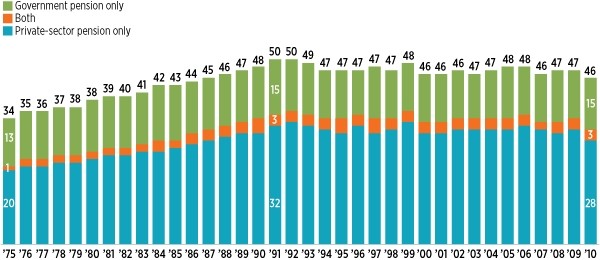
News Release
Private-Sector Retirement Income More Prevalent over Time
Study Examines Evolution of Retirement Income Since 1974 ERISA
Washington, DC, December 6, 2011 - A study released today by the Investment Company Institute found that across all income groups, retirement income from private-sector employer-sponsored retirement plans is more prevalent among retirees today than in the mid-1970s, when sweeping new retirement plan regulations were enacted.
The study, A Look at Private-Sector Retirement Plan Income After ERISA, 2010, finds that in 2010, 31 percent of retirees received income—either directly or through a spouse—from private-sector retirement plans, compared with 21 percent in 1975. The median income received by those with private-sector pension income increased to $6,000 in 2010 from about $4,500 in 1975 (in 2010 dollars). The research examines private-sector retirement income trends since 1974 just after the Employee Retirement Income Security Act (ERISA) was enacted.
Receipt of Income from Pensions by Type of Pension (Percentage of retirees* with type of pension income, 1975–2010)

*Individuals aged 65 and older with nonzero income and not working; for married couples, neither the individual nor the spouse worked. Sample excludes highest 1 percent and lowest 1 percent of the income distribution.
Source: ICI tabulations of March Current Population Surveys
“This paper has shown that, contrary to conventional wisdom, during the entire period from 1975 to 2010 private-sector pension income has become more prevalent over time, not less prevalent,” said Peter Brady, ICI senior economist and coauthor of the report. “This report refutes the belief that retirees’ pension income has fallen over time, which is the basis of many retirement policy discussions. This report provides some historical context for these policy discussions by examining trends in retiree income from private-sector pensions.”
Evolution of Employer-Sponsored Retirement Plans Since ERISA
U.S. worker access to private-sector retirement plans at their current employer has been substantial and remained steady since the 1970s. While coverage has been consistent, an increasing share of private-sector workers has worked for employers that sponsor defined contribution (DC) pension plans, and a decreasing share has worked for employers that sponsor defined benefit (DB) pension plans. In 1975, nearly 90 percent of active participants in private-sector retirement plans had primary coverage through DB plans, dropping steadily over time to below 50 percent through the 1990s. By 1998, 44 percent of active participants in private-sector retirement plans had coverage through DB plans.
“Coverage” Does Not Always Result in Retirement Income
The historical prevalence of retirement income from private-sector DB plans may be overstated by looking only at pension coverage, rather than receipt of pension income. Many retirees may have worked for companies that offered DB pension plans, but, because private-sector workers change jobs often, the combination of vesting rules and the timing of benefit accrual resulted in many retirees getting little or no retirement income from private-sector retirement plans.
“The amount of retirement income that previous generations received from private-sector DB pensions is often exaggerated. In fact, the amount of income generated by private-sector retirement plans has increased over time and, to date, the shift from DB pensions to DC pensions has not led to a decline in private-sector pension income,” said Brady. “Furthermore, the typical amount of private-sector pension income that we observe in the historical data can be generated by relatively modest accumulations in DC plans or IRAs.”
Ongoing Role of Social Security in Retirement
Since 1975, there has been little change in the importance of Social Security benefits in providing retiree income: Social Security benefits continue to serve as the foundation for retirement security in the United States and represent the largest component of retiree income and the predominant income source for lower-income retirees. In 2010, Social Security benefits were 57 percent of total retiree income and more than 85 percent of income for retirees in the lowest 40 percent of the income distribution. Even for retirees in the highest income quintile, Social Security benefits represented about one-third of income in 2010.
The study was coauthored by Brady and ICI associate economist Michael Bogdan. Readers may review supplementary figures with additional detail at www.ici.org/info/per17-09_data.xls.
